United States Army Reserve Command
| United States Army Reserve | |
|---|---|
|
USARC Shoulder Sleeve Insignia | |
| Active | 1908–present |
| Country | United States |
| Branch | United States Army Reserve |
| Size | 205,000[1] |
| Garrison/HQ | Fort Bragg |
| Motto(s) | "Twice the Citizen" |
| Anniversaries | 23 April |
| Commanders | |
| Current commander | Lieutenant General Charles D. Luckey |
| Insignia | |
| Distinctive unit insignia |
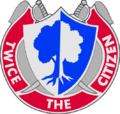 |
United States Army Reserve Command (USARC) commands all United States Army Reserve units. USARC is responsible for the staffing, training, management and deployment of its units to ensure their readiness for Army missions. The Army Reserve which consists of three main categories of units.
Mission
U.S. Army Reserve Command (USARC) mission is to provide trained and ready units and individuals to mobilize and deploy in support of the national military strategy. USARC is responsible for all of the operational tasks involved in training, equipping, managing, supporting, mobilizing and retaining Soldiers under its command. USARC has over 20 offices, each with an individual mission and function that contributes to the accomplishment of USARC’s overall mission.[2]
- Operational groups such as personnel, logistics, operations, training and resource management are responsible for the daily work involved in managing, training and equipping the Army Reserve’s Soldiers and units across the continental United States.
- Special staff offices provide technical support and guidelines to USARC and Army Reserve units across the country. These offices include public affairs, safety and enterprise services.
- The Executive staff includes the leaders of the USARC and their personal staff. The leaders are the Commanding General, the Deputy Commanding General, the Chief of Staff and the Command Sergeant Major. The personal staff includes the Staff Judge Advocate (legal), Inspector General, Historian and Chaplain.
Establishment of the Chief, Army Reserve
As the evolutionary process continued, there were more congressional hearings and investigations and major reorganizations of the Army, including Secretary of Defense Robert S. McNamara's failed attempt between 1965 and 1966 to merge units of the Army Reserve into the National Guard. In 1967, Congress passed watershed legislation in the form of the Reserve Forces Bill of Rights and Vitalization Act. In essence that act, among other features, prescribed reserve leadership for reserve units. For the Army, the act created a statutory Chief, Army Reserve (CAR) who served as an advisor to the Chief of Staff on Army Reserve matters. Command and Control of the Army Reserve, however, was under Continental Army Command (CONARC) until 1973 and after that under Forces Command (FORSCOM). The act also virtually eliminated bitter congressional deliberation over reserve component policy--for a while.
Congress Directs Design of a Command and Control Plan
In 1988, the House Committee on Appropriations Surveys and Investigation rekindled the debate. The committee uncovered two command and control reporting chains for the Army Reserve: FORSCOM and the CAR. Unlike the Air Force Reserve and the Navy Reserve, the CAR did not have sole command of the Army Reserve. In 1989, Congress directed the Army to design a command and control plan for the Army Reserve. Congress and the Army, with FORSCOM in the lead, began the struggle, at times difficult, to produce a mutually agreeable arrangement for the Army Reserve.
FORSCOM, the Office of the Chief Army Reserve (OCAR), the Department of the Army, and Congress each had its own plan. Command and Control options spanned from the creation of an independent major command to a major subordinate command under FORSCOM.
Major Subordinate Command Status
On 18 January 1990, the CAR and the FORSCOM commander reached an agreement, a major step in the evolution of the new command. The Army's plan called for the command to be organized as a major subordinate command. FORSCOM was to develop overall policy for units of the U.S. Army Reserve (USAR), while the Reserve Command was to prepare implementation procedures, plans, and programs in accordance with FORSCOM guidance. Integration of the active component and reserve component into a total force was the ultimate objective.
U.S. Army Reserve Command Planning Group
As the plans were staffed and reviewed, FORSCOM pushed forward in March 1990 by creating the U.S. Army Reserve Command (USARC) Planning Group charged with providing the functional nucleus to plan and develop the details for establishing the USARC (e.g., table of distribution and allowance, organization and functions manual, etc.). The USARC Planning Group was to evolve into the heart of the new USARC headquarters. Meanwhile, Congress and the Army had differing views on the next course of action. In the midst of this came another negotiated agreement between the OCAR and FORSCOM, the management of USAR funds.
U.S. Army Reserve Command (Provisional)
Permanent Order 183-13 dated 1 October 1990 established the U.S. Army Reserve Command (Provisional). Congress legally formalized this arrangement in November 1990 with passage of the National Defense Authorization Act for Fiscal Year 1991. The act assigned to the command all Army Reserve forces in the continental United States, save those assigned to Special Operations Forces and those forces as directed by the Secretary of Defense. The act set a test period of two years for operation of the Command and required the Secretary of the Army during the test period to submit semiannual reports on the command to the Committee on Armed Services of both congressional houses. The act directed the Secretary of the Army to establish an independent commission assisting the Secretary of the Army in evaluating the progress and effectiveness of the command. Twenty-three years after passage of the Reserve Forces Bill of Rights and Vitalization Act, the CAR was in statutory command of the Army Reserve.
Evolution of a Fully Operational Command
There was much to be done in a year, the time schedule for evolution of the USARC into a fully operational command. Congress directed the development of a concept plan for the new command. FORSCOM and the USARC Planning Group worked for months on resolving differences, for example, in the organization and functions manual. Other actions ranged from developing a plan to transition functions from the Continental U.S. Armies and FORSCOM to the USARC to finding a home for the USARC and hiring personnel. Evolution into a fully operational command came on 18 October 1991 with Permanent Order 54-15.
In the spring of 1990, building 906 at Fort Gillem served as the temporary headquarters for the planning group from which the USARC evolved. The USARC occupied two other temporary sites, including a leased facility at Camp Creek Business Center, until the fall of 1997 when the command relocated to its permanent home on Fort McPherson. In 2011, the Headquarters moved to Fort Bragg, North Carolina.
Subordinate units
Operational and functional commands
<div class="div-col columns column-count column-count-*![]() 1st Mission Support Command "Garita Warriors" at Fort Buchanan, Puerto Rico
1st Mission Support Command "Garita Warriors" at Fort Buchanan, Puerto Rico
 11th Theater Aviation Command at Fort Knox, Kentucky
11th Theater Aviation Command at Fort Knox, Kentucky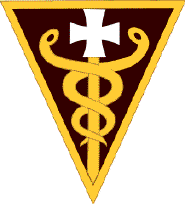 3rd Medical Command (Deployment Support) (MDSC) at Forest Park, Georgia
3rd Medical Command (Deployment Support) (MDSC) at Forest Park, Georgia 7th Civil Support Command at Kaiserslautern, Germany
7th Civil Support Command at Kaiserslautern, Germany 76th Operational Response Command (ORC) at Salt Lake City, Utah
76th Operational Response Command (ORC) at Salt Lake City, Utah 79th Sustainment Support Command at Los Alamitos, California
79th Sustainment Support Command at Los Alamitos, California 200th Military Police Command at Fort Meade, Maryland
200th Military Police Command at Fort Meade, Maryland 335th Signal Command (Theater) at East Point, Georgia
335th Signal Command (Theater) at East Point, Georgia 377th Sustainment Theater Command (TSC) at Belle Chasse, Louisiana
377th Sustainment Theater Command (TSC) at Belle Chasse, Louisiana 412th Theater Engineer Command (TEC) at Vicksburg, Mississippi
412th Theater Engineer Command (TEC) at Vicksburg, Mississippi 416th Engineer Command (TEC) at Darien, Illinois
416th Engineer Command (TEC) at Darien, Illinois 807th Medical Command (Deployment Support) (MDSC) at Fort Douglas, Salt Lake City, Utah
807th Medical Command (Deployment Support) (MDSC) at Fort Douglas, Salt Lake City, Utah United States Army Reserve Medical Command (AR-MEDCOM) at Pinellas Park, Florida
United States Army Reserve Medical Command (AR-MEDCOM) at Pinellas Park, Florida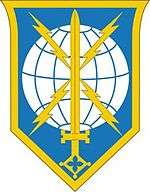 Military Intelligence Readiness Command (MIRC) at Fort Belvoir, Virginia
Military Intelligence Readiness Command (MIRC) at Fort Belvoir, Virginia_small.jpg) United States Army Civil Affairs and Psychological Operations Command – Airborne (USACAPOC-A) at Fort Bragg, North Carolina" style="-moz-column-count: *
United States Army Civil Affairs and Psychological Operations Command – Airborne (USACAPOC-A) at Fort Bragg, North Carolina" style="-moz-column-count: *.svg.png) 1st Mission Support Command "Garita Warriors" at Fort Buchanan, Puerto Rico
1st Mission Support Command "Garita Warriors" at Fort Buchanan, Puerto Rico 11th Theater Aviation Command at Fort Knox, Kentucky
11th Theater Aviation Command at Fort Knox, Kentucky 3rd Medical Command (Deployment Support) (MDSC) at Forest Park, Georgia
3rd Medical Command (Deployment Support) (MDSC) at Forest Park, Georgia 7th Civil Support Command at Kaiserslautern, Germany
7th Civil Support Command at Kaiserslautern, Germany 76th Operational Response Command (ORC) at Salt Lake City, Utah
76th Operational Response Command (ORC) at Salt Lake City, Utah 79th Sustainment Support Command at Los Alamitos, California
79th Sustainment Support Command at Los Alamitos, California 200th Military Police Command at Fort Meade, Maryland
200th Military Police Command at Fort Meade, Maryland 335th Signal Command (Theater) at East Point, Georgia
335th Signal Command (Theater) at East Point, Georgia 377th Sustainment Theater Command (TSC) at Belle Chasse, Louisiana
377th Sustainment Theater Command (TSC) at Belle Chasse, Louisiana 412th Theater Engineer Command (TEC) at Vicksburg, Mississippi
412th Theater Engineer Command (TEC) at Vicksburg, Mississippi 416th Engineer Command (TEC) at Darien, Illinois
416th Engineer Command (TEC) at Darien, Illinois 807th Medical Command (Deployment Support) (MDSC) at Fort Douglas, Salt Lake City, Utah
807th Medical Command (Deployment Support) (MDSC) at Fort Douglas, Salt Lake City, Utah United States Army Reserve Medical Command (AR-MEDCOM) at Pinellas Park, Florida
United States Army Reserve Medical Command (AR-MEDCOM) at Pinellas Park, Florida Military Intelligence Readiness Command (MIRC) at Fort Belvoir, Virginia
Military Intelligence Readiness Command (MIRC) at Fort Belvoir, Virginia_small.jpg) United States Army Civil Affairs and Psychological Operations Command – Airborne (USACAPOC-A) at Fort Bragg, North Carolina; -webkit-column-count: *
United States Army Civil Affairs and Psychological Operations Command – Airborne (USACAPOC-A) at Fort Bragg, North Carolina; -webkit-column-count: *.svg.png) 1st Mission Support Command "Garita Warriors" at Fort Buchanan, Puerto Rico
1st Mission Support Command "Garita Warriors" at Fort Buchanan, Puerto Rico 11th Theater Aviation Command at Fort Knox, Kentucky
11th Theater Aviation Command at Fort Knox, Kentucky 3rd Medical Command (Deployment Support) (MDSC) at Forest Park, Georgia
3rd Medical Command (Deployment Support) (MDSC) at Forest Park, Georgia 7th Civil Support Command at Kaiserslautern, Germany
7th Civil Support Command at Kaiserslautern, Germany 76th Operational Response Command (ORC) at Salt Lake City, Utah
76th Operational Response Command (ORC) at Salt Lake City, Utah 79th Sustainment Support Command at Los Alamitos, California
79th Sustainment Support Command at Los Alamitos, California 200th Military Police Command at Fort Meade, Maryland
200th Military Police Command at Fort Meade, Maryland 335th Signal Command (Theater) at East Point, Georgia
335th Signal Command (Theater) at East Point, Georgia 377th Sustainment Theater Command (TSC) at Belle Chasse, Louisiana
377th Sustainment Theater Command (TSC) at Belle Chasse, Louisiana 412th Theater Engineer Command (TEC) at Vicksburg, Mississippi
412th Theater Engineer Command (TEC) at Vicksburg, Mississippi 416th Engineer Command (TEC) at Darien, Illinois
416th Engineer Command (TEC) at Darien, Illinois 807th Medical Command (Deployment Support) (MDSC) at Fort Douglas, Salt Lake City, Utah
807th Medical Command (Deployment Support) (MDSC) at Fort Douglas, Salt Lake City, Utah United States Army Reserve Medical Command (AR-MEDCOM) at Pinellas Park, Florida
United States Army Reserve Medical Command (AR-MEDCOM) at Pinellas Park, Florida Military Intelligence Readiness Command (MIRC) at Fort Belvoir, Virginia
Military Intelligence Readiness Command (MIRC) at Fort Belvoir, Virginia_small.jpg) United States Army Civil Affairs and Psychological Operations Command – Airborne (USACAPOC-A) at Fort Bragg, North Carolina; column-count: *
United States Army Civil Affairs and Psychological Operations Command – Airborne (USACAPOC-A) at Fort Bragg, North Carolina; column-count: *.svg.png) 1st Mission Support Command "Garita Warriors" at Fort Buchanan, Puerto Rico
1st Mission Support Command "Garita Warriors" at Fort Buchanan, Puerto Rico 11th Theater Aviation Command at Fort Knox, Kentucky
11th Theater Aviation Command at Fort Knox, Kentucky 3rd Medical Command (Deployment Support) (MDSC) at Forest Park, Georgia
3rd Medical Command (Deployment Support) (MDSC) at Forest Park, Georgia 7th Civil Support Command at Kaiserslautern, Germany
7th Civil Support Command at Kaiserslautern, Germany 76th Operational Response Command (ORC) at Salt Lake City, Utah
76th Operational Response Command (ORC) at Salt Lake City, Utah 79th Sustainment Support Command at Los Alamitos, California
79th Sustainment Support Command at Los Alamitos, California 200th Military Police Command at Fort Meade, Maryland
200th Military Police Command at Fort Meade, Maryland 335th Signal Command (Theater) at East Point, Georgia
335th Signal Command (Theater) at East Point, Georgia 377th Sustainment Theater Command (TSC) at Belle Chasse, Louisiana
377th Sustainment Theater Command (TSC) at Belle Chasse, Louisiana 412th Theater Engineer Command (TEC) at Vicksburg, Mississippi
412th Theater Engineer Command (TEC) at Vicksburg, Mississippi 416th Engineer Command (TEC) at Darien, Illinois
416th Engineer Command (TEC) at Darien, Illinois 807th Medical Command (Deployment Support) (MDSC) at Fort Douglas, Salt Lake City, Utah
807th Medical Command (Deployment Support) (MDSC) at Fort Douglas, Salt Lake City, Utah United States Army Reserve Medical Command (AR-MEDCOM) at Pinellas Park, Florida
United States Army Reserve Medical Command (AR-MEDCOM) at Pinellas Park, Florida Military Intelligence Readiness Command (MIRC) at Fort Belvoir, Virginia
Military Intelligence Readiness Command (MIRC) at Fort Belvoir, Virginia_small.jpg) United States Army Civil Affairs and Psychological Operations Command – Airborne (USACAPOC-A) at Fort Bragg, North Carolina; ">
United States Army Civil Affairs and Psychological Operations Command – Airborne (USACAPOC-A) at Fort Bragg, North Carolina; ">.svg.png) 1st Mission Support Command "Garita Warriors" at Fort Buchanan, Puerto Rico
1st Mission Support Command "Garita Warriors" at Fort Buchanan, Puerto Rico 11th Theater Aviation Command at Fort Knox, Kentucky
11th Theater Aviation Command at Fort Knox, Kentucky 3rd Medical Command (Deployment Support) (MDSC) at Forest Park, Georgia
3rd Medical Command (Deployment Support) (MDSC) at Forest Park, Georgia 7th Civil Support Command at Kaiserslautern, Germany
7th Civil Support Command at Kaiserslautern, Germany 76th Operational Response Command (ORC) at Salt Lake City, Utah
76th Operational Response Command (ORC) at Salt Lake City, Utah 79th Sustainment Support Command at Los Alamitos, California
79th Sustainment Support Command at Los Alamitos, California 200th Military Police Command at Fort Meade, Maryland
200th Military Police Command at Fort Meade, Maryland 335th Signal Command (Theater) at East Point, Georgia
335th Signal Command (Theater) at East Point, Georgia 377th Sustainment Theater Command (TSC) at Belle Chasse, Louisiana
377th Sustainment Theater Command (TSC) at Belle Chasse, Louisiana 412th Theater Engineer Command (TEC) at Vicksburg, Mississippi
412th Theater Engineer Command (TEC) at Vicksburg, Mississippi 416th Engineer Command (TEC) at Darien, Illinois
416th Engineer Command (TEC) at Darien, Illinois 807th Medical Command (Deployment Support) (MDSC) at Fort Douglas, Salt Lake City, Utah
807th Medical Command (Deployment Support) (MDSC) at Fort Douglas, Salt Lake City, Utah United States Army Reserve Medical Command (AR-MEDCOM) at Pinellas Park, Florida
United States Army Reserve Medical Command (AR-MEDCOM) at Pinellas Park, Florida Military Intelligence Readiness Command (MIRC) at Fort Belvoir, Virginia
Military Intelligence Readiness Command (MIRC) at Fort Belvoir, Virginia_small.jpg) United States Army Civil Affairs and Psychological Operations Command – Airborne (USACAPOC-A) at Fort Bragg, North Carolina
United States Army Civil Affairs and Psychological Operations Command – Airborne (USACAPOC-A) at Fort Bragg, North Carolina
Support commands
 9th Mission Support Command at Fort Shafter, Hawaii
9th Mission Support Command at Fort Shafter, Hawaii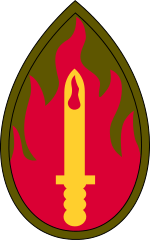 63rd Regional Support Command "Blood and Fire" at Moffett Federal Airfield, California
63rd Regional Support Command "Blood and Fire" at Moffett Federal Airfield, California 81st Regional Support Command "Wildcat Division" at Fort Jackson, South Carolina
81st Regional Support Command "Wildcat Division" at Fort Jackson, South Carolina 85th Support Command "Custer Division" at Arlington Heights, Illinois
85th Support Command "Custer Division" at Arlington Heights, Illinois 87th Support Command "The Golden Acorn Division" at Birmingham, Alabama
87th Support Command "The Golden Acorn Division" at Birmingham, Alabama 88th Regional Support Command "The Blue Devils" at Fort McCoy, Wisconsin
88th Regional Support Command "The Blue Devils" at Fort McCoy, Wisconsin 99th Regional Support Command "Checkerboard" at Fort Dix, New Jersey
99th Regional Support Command "Checkerboard" at Fort Dix, New Jersey Army Reserve Careers Division at Fort Knox, Kentucky
Army Reserve Careers Division at Fort Knox, Kentucky
Training commands, institutional
.svg.png) 75th Training Command (Battle Command Training Division) at Houston, Texas
75th Training Command (Battle Command Training Division) at Houston, Texas 80th Training Command (TASS) "Blue Ridge Division" at Richmond, Virginia
80th Training Command (TASS) "Blue Ridge Division" at Richmond, Virginia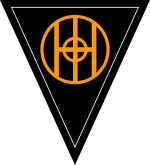 83rd Army Reserve Readiness Training Center (USARRTC) at at Fort Knox, Kentucky
83rd Army Reserve Readiness Training Center (USARRTC) at at Fort Knox, Kentucky 84th Training Command "Lincoln County Division" at Fort McCoy, Wisconsin
84th Training Command "Lincoln County Division" at Fort McCoy, Wisconsin 108th Training Command (Initial Entry Training) "Golden Griffins" at Charlotte, North Carolina
108th Training Command (Initial Entry Training) "Golden Griffins" at Charlotte, North Carolina
Special units
-
 100th Battalion, 442nd Infantry (part of the 9th Mission Support Command)
100th Battalion, 442nd Infantry (part of the 9th Mission Support Command) - USAR Small Arms Readiness Group
- USAR Shooting Team
Unit insignia
Shoulder sleeve insignia[3]
Description
On a disc divided vertically blue and scarlet with a 1⁄8 inch (0.32 cm) yellow border, 3 inches (7.6 cm) in diameter overall, two white eagles’ heads conjoined back to back, beaks yellow, eyes detailed black.
Symbolism
The two eagles’ heads are in reference to the unit’s motto, “Twice the Citizen,” and their Reserve mission. The eagle faces in both directions, denoting vigilance and a wide-ranging scope of ability and expertise. Red, white and blue are the colors of the United States; gold stands for excellence.
Background
A shoulder sleeve insignia was originally authorized on 24 June 1991 for the U.S. Army Reserve Command. On 26 August 1997 the insignia was cancelled and the new insignia was authorized.
Distinctive unit insignia[3]
Description
A silver color metal and enamel device 1 1⁄8 inches (2.9 cm) in width overall, consisting of a shield divided palewise silver and blue charged with a tree in full foliage counter changed of the field, all upon two silver sabres saltirewise, points down, the tips overlaying a scarlet motto scroll enclosing the device and terminating at the sword hilts, bearing the inscription “TWICE THE CITIZEN” in silver letters.
Symbolism
Blue and scarlet, with silver (white), represent the United States. Red also stands for courage and sacrifice. The dual responsibilities of citizenship and military service are denoted by the two sabres, and the integration of peaceful with soldierly vocations is represented by the tree on the shield. The nature of these two-fold duties is further symbolized by the division and counter change of the shield, which also recalls the motto of the Command. The tree represents the pursuit and preservation of peace through strength, endurance and growth.
Background
The distinctive unit insignia was authorized on 7 March 1991.
References
- ↑ Hon. John M. McHugh; Gen. George W. Casey Jr. (2010). 2010 Army Posture Statement. HQ Department of the Army. p. 9. Retrieved 28 May 2010. Cite uses deprecated parameter
|coauthors=(help) - ↑ "United State Army Reserve Command". Retrieved 30 May 2010.
- 1 2 "The Institute of Heraldry: US Army Reserve Command". Retrieved 30 May 2010.
External links
| Wikimedia Commons has media related to United States Army Reserve Command. |
